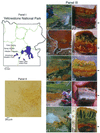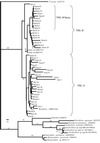Molecular characterization of novel red green nonsulfur bacteria from five distinct hot spring communities in Yellowstone National Park
- PMID: 11772644
- PMCID: PMC126577
- DOI: 10.1128/AEM.68.1.346-355.2002
Molecular characterization of novel red green nonsulfur bacteria from five distinct hot spring communities in Yellowstone National Park
Abstract
We characterized and compared five geographically isolated hot springs with distinct red-layer communities in Yellowstone National Park. Individual red-layer communities were observed to thrive in temperatures ranging from 35 to 60 degrees C and at pH 7 to 9. All communities were dominated by red filamentous bacteria and contained bacteriochlorophyll a (Bchl a), suggesting that they represented novel green nonsulfur (GNS) bacteria. The in vivo absorption spectra of individual sites were different, with two sites showing unusual Bchl a protein absorption bands beyond 900 nm. We prepared and analyzed 16S rRNA libraries from all of these sites by using a combination of general bacterial primers and new GNS-specific primers described here. These studies confirmed the presence of novel GNS-like bacteria in all five communities. All GNS-like clones were most similar to Roseiflexus castenholzii, a red filamentous bacterium from Japan that also contains only Bchl a. Phylogenies constructed by using GNS-like clones from Yellowstone red-layer communities suggest the presence of a moderately diverse new "red" cluster within the GNS lineage. Within this cluster, at least two well-supported subclusters emerged: YRL-A was most similar to Roseiflexus and YRL-B appeared to be novel, containing no known isolates. While these patterns showed some site specificity, they did not correlate with observed Bchl a spectrum differences or obvious features of the habitat.
Figures



References
-
- Altschul, S. F., W. Gish, W. Miller, E. W. Myers, and D. J. Lipman. 1990. Basic local alignment search tool. J. Mol. Biol. 215:403–410. - PubMed
-
- Ausubel, F., R. Brent, R. E. Kingston, D. D. Moore, J. G. Seidman, J. A. Smith, and K. Struhl (ed.). 1997. Short protocols in molecular biology, 3rd ed. John Wiley & Sons, Inc., New York, N.Y.
-
- Boomer, S. M., B. K. Pierson, R. Austinhirst, and R. W. Castenholz. 2000. Characterization of novel bacteriochlorophyll-a-containing red filaments from alkaline hot springs in Yellowstone National Park. Arch. Microbiol. 174:152–161. - PubMed
-
- Castenholz, R. W. 1984. Microbial mats: stromatolites. Alan R. Liss, Inc., New York, N.Y.
Publication types
MeSH terms
Substances
LinkOut - more resources
Full Text Sources
Molecular Biology Databases

